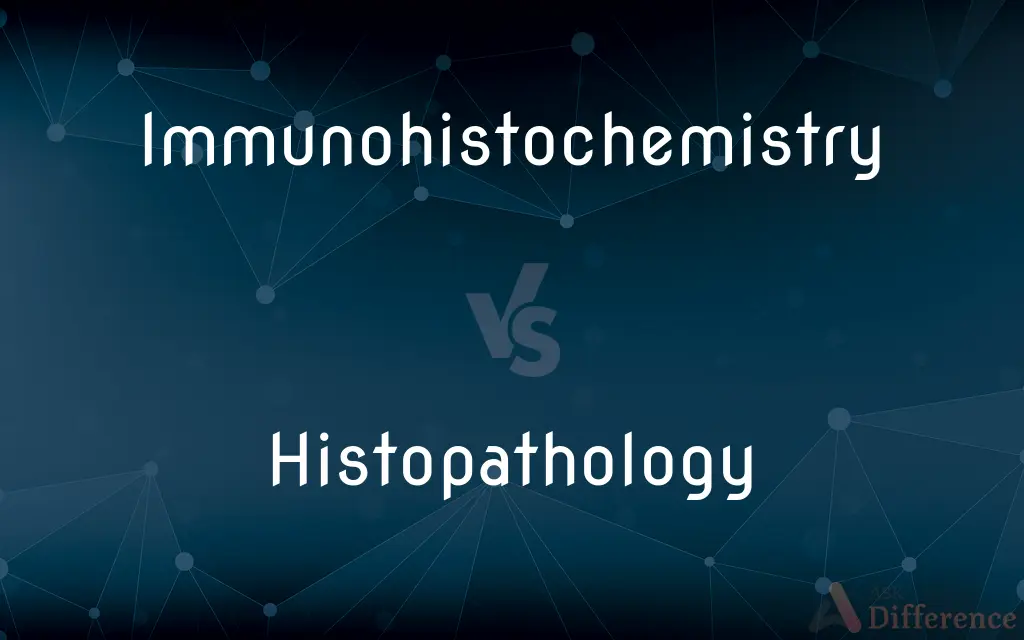Immunohistochemistry vs. Histopathology — What's the Difference?
By Tayyaba Rehman & Maham Liaqat — Updated on April 6, 2024
Immunohistochemistry involves labeling proteins in tissue sections for study, while histopathology is the examination of tissues to diagnose diseases.

Difference Between Immunohistochemistry and Histopathology
Table of Contents
ADVERTISEMENT
Key Differences
Immunohistochemistry (IHC) is a technique used to identify specific antigens (proteins) in cells of a tissue section by exploiting the principle of antibodies binding specifically to antigens in biological tissues. Whereas, histopathology is the study and analysis of tissue samples to detect abnormal conditions or diseases, primarily through microscopic examination. It focuses on the architecture and the state of cells to diagnose diseases.
IHC uses labeled antibodies as markers to visualize the presence, abundance, and localization of specific proteins. This can highlight patterns of protein expression within cells and tissues, providing insights into pathological conditions, such as cancer. On the other hand, histopathology relies on staining techniques, such as Hematoxylin and Eosin (H&E), to provide a more general view of tissue structure and identify abnormalities in cell size, shape, and organization.
While IHC is particularly valuable for diagnosing types of cancer, identifying infectious agents, and differentiating between benign and malignant tumors by highlighting specific protein markers, histopathology serves as a fundamental tool for the overall diagnosis of diseases through tissue examination. It helps in understanding the morphology and pathology of tissues without specifically identifying protein expression.
IHC can be considered more specialized than histopathology because it provides targeted information about protein expressions within tissues, aiding in the identification of specific types of diseases, especially cancers. Whereas histopathology offers a broader examination of tissue structure and pathology, making it essential for diagnosing a wide range of conditions.
Both techniques are complementary in the field of pathology. Immunohistochemistry adds a layer of specificity to the morphological insights provided by histopathology, enabling pathologists to make more accurate diagnoses and treatment decisions. Whereas, histopathology lays the groundwork by identifying the overall pathological changes in tissues.
ADVERTISEMENT
Comparison Chart
Ocus
Specific proteins in tissues
General tissue structure and abnormalities
Technique
Uses antibodies to detect antigens
Uses stains to highlight cellular structures
Applications
Diagnosing cancer, identifying infectious agents
Diagnosing a wide range of diseases
Specificity
High, due to targeted antibody-antigen reactions
Lower, focuses on morphology
Complementary Role
Provides detailed information on protein expression
Provides foundational understanding of tissue pathology
Compare with Definitions
Immunohistochemistry
A laboratory technique that uses antibodies to detect specific antigens in a tissue section.
Immunohistochemistry is crucial for identifying the presence of HER2 protein in breast cancer tissues.
Histopathology
Essential for the diagnosis, study, and management of cancers.
Histopathology is fundamental in determining the grade and stage of cancers.
Immunohistochemistry
Involves the application of antibody-based staining to visualize cellular components.
The pathologist used immunohistochemistry to highlight the tumor cells in the sample.
Histopathology
Focuses on morphological changes to diagnose various conditions.
Histopathology showed inflammation and fibrosis, indicating chronic hepatitis.
Immunohistochemistry
Can differentiate between benign and malignant tumors through protein markers.
By using immunohistochemistry, the benign nature of the tumor was confirmed due to the absence of specific protein markers.
Histopathology
The study of diseased tissue under a microscope to diagnose conditions.
Histopathology of the biopsy sample confirmed the diagnosis of melanoma.
Immunohistochemistry
Utilizes fluorescent or chromogenic labels attached to antibodies.
Fluorescent labels in immunohistochemistry allow for the visualization of multiple antigens simultaneously.
Histopathology
Examines samples from biopsies, surgeries, or autopsies to detect disease.
The surgeon sent the removed tissue for histopathology to check for signs of cancer.
Immunohistochemistry
Helps in the diagnosis and research of diseases by revealing protein expressions.
Immunohistochemistry revealed an overexpression of the protein, indicating a specific type of lymphoma.
Histopathology
Involves staining tissue sections to examine cell structure and tissue architecture.
Hematoxylin and eosin staining in histopathology highlighted the tissue's detailed structure.
Immunohistochemistry
Immunohistochemistry (IHC) is the most common application of immunostaining. It involves the process of selectively identifying antigens (proteins) in cells of a tissue section by exploiting the principle of antibodies binding specifically to antigens in biological tissues.
Histopathology
Histopathology (compound of three Greek words: ἱστός histos "tissue", πάθος pathos "suffering", and -λογία -logia "study of") refers to the microscopic examination of tissue in order to study the manifestations of disease. Specifically, in clinical medicine, histopathology refers to the examination of a biopsy or surgical specimen by a pathologist, after the specimen has been processed and histological sections have been placed onto glass slides.
Immunohistochemistry
The analytical process of finding proteins in cells of a tissue microtome section exploiting the principle of antibodies binding specifically to antigens in biological tissues.
Histopathology
The study of changes in tissues caused by disease.
Immunohistochemistry
An assay that shows specific antigens in tissues by the use of markers that are either fluorescent dyes or enzymes (such as horseradish peroxidase)
Histopathology
The study of the microscopic anatomical changes in diseased tissue.
Histopathology
(biology) The microscopic study of tissue, especially of abnormal tissue as a result of disease.
Common Curiosities
Can immunohistochemistry detect cancer?
Yes, by identifying specific protein markers associated with cancer cells, it can help in diagnosing and classifying cancers.
How do immunohistochemistry and histopathology complement each other in diagnostics?
Immunohistochemistry provides specific information about protein expression, enhancing the morphological insights gained from histopathology, leading to more accurate disease diagnoses.
Is immunohistochemistry always necessary for diagnosing diseases?
While not always necessary, it provides valuable, specific information that can aid in the diagnosis of certain conditions.
How do antibodies work in immunohistochemistry?
Antibodies bind to specific antigens in the tissue, allowing for visualization and identification of target proteins.
What is the main difference between immunohistochemistry and histopathology?
Immunohistochemistry focuses on detecting specific proteins in tissues, while histopathology examines tissue structure and abnormalities for disease diagnosis.
Why is staining important in histopathology?
Staining highlights different cellular components and structures, making it easier to identify abnormalities under a microscope.
Can immunohistochemistry be used for all types of diseases?
It is most valuable for diseases where specific protein markers are known, such as various cancers and infectious diseases.
What makes histopathology essential in disease diagnosis?
Histopathology offers a broad examination of tissue structure, essential for diagnosing a wide range of conditions and understanding the overall pathology.
What is the role of histopathology in cancer treatment?
It helps in diagnosing cancer, determining its grade and stage, and guiding treatment decisions.
How does the choice between immunohistochemistry and histopathology affect treatment planning?
Detailed information from both methods can guide more personalized and effective treatment strategies.
What challenges do pathologists face when interpreting results from histopathology and immunohistochemistry?
Interpreting the complex data requires extensive expertise and understanding of disease mechanisms and tissue biology.
What advancements have been made in immunohistochemistry techniques?
Developments include multiplex staining and improved detection methods, allowing for more detailed analysis.
Can histopathology and immunohistochemistry be performed on the same tissue sample?
Yes, they are often used together on the same sample to provide comprehensive diagnostic information.
How has immunohistochemistry improved disease diagnosis?
It has increased the accuracy of diagnoses by allowing for the specific detection of disease markers.
Are there any limitations to using histopathology alone for diagnosis?
While comprehensive, it may not provide the specificity required for certain diagnoses, where immunohistochemistry can offer additional insights.
Share Your Discovery

Previous Comparison
Cabal vs. Cabala
Next Comparison
Purple vs. AubergineAuthor Spotlight
Written by
Tayyaba RehmanTayyaba Rehman is a distinguished writer, currently serving as a primary contributor to askdifference.com. As a researcher in semantics and etymology, Tayyaba's passion for the complexity of languages and their distinctions has found a perfect home on the platform. Tayyaba delves into the intricacies of language, distinguishing between commonly confused words and phrases, thereby providing clarity for readers worldwide.
Co-written by
Maham Liaqat















































